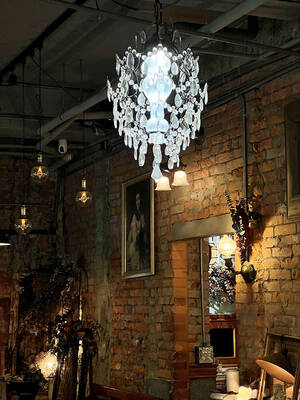For his newest film, Face (臉), Tsai Ming-liang (蔡明亮) prowled the insides of the Louvre with the aid of an art student and the museum’s fireman. It was a time of great anxiety and stress for Tsai, who had to cope with the loss of his mother to cancer in the middle of the three-year-long filmmaking process, before he had even finished the script.
Face was commissioned by the Louvre as the first project under an initiative in which the museum is giving access to its premises to a group of directors and partially funding the movies they film there. It reflects Tsai’s grief and personal frustrations as disclosed through stunning images and inexplicable events that are linked by imagination and association rather than narrative connections, blurring the boundary between reality and dreams. In a sense, the film is itself a dream in which Tsai performs rituals to summon up the ghosts of his late mother and French auteur Francois Truffaut, to whom the Malaysia-born director pays tribute with Face.
More obscure and discursive than the director’s previous works, Face is about a Taiwanese director shooting a film about the myth of Salome at the Louvre — audiences need to be familiar with the myth to grasp the point. The vaguely defined storyline begins with the director, Hsiao Kang (played by Tsai’s alter-ego Lee Kang-sheng, 李康生), looking for Truffaut’s alter ego Jean-Pierre Leaud, who began his career as the runaway boy Antoine in Truffaut’s The 400 Blows, to play King Herod in his movie.
The story alternates between dreamlike happenings and musical sequences that involve the ravishing Laetitia Casta, who plays Salome, lip-synching Chinese ballads in a snowy forest or in a sewer beneath the Louvre. There is also a restless film producer (played by Fanny Ardant, Truffaut’s actress and last partner in life) looking in vain for a stag, an animal character in the movie-within-the-movie, which has gone missing in the gardens of Tuileries palace.
The narrative bewilderment is mitigated to a certain extent when the story emerges halfway through the movie. Kang receives news of his mother’s death when Mathieu Amalric, in a brief cameo, performs oral sex on him in the gardens. Kang returns to Taipei, only to fall into a dreamless slumber in his dimly lit claustrophobic apartment, which is haunted by his mother’s ghost.
Eventually, the director awakes and
returns to Paris to finish the movie, only to find that his actors are lost in the Louvre’s labyrinthine basement.
Captivated by the face of the little boy Antoine when he first saw The 400 Blows, Tsai repeatedly said Face originated with his desire to film the aging face of Leaud, who also appears in Tsai’s 2001 What Time Is It Over There? (你那邊幾點). Face is heavy on references to Truffaut, one of the founders of French New Wave cinema. In one of the film’s most memorable scenes, Lee (Tsai’s stand-in) and Leaud (Truffaut’s stand-in) are seen alone on the set of the Salome film. Speaking in broken English, the two can hardly understand each other, but they play a game in which they take turns recalling the names of past cinematic masters.
Tsai further summons Truffaut’s three muses, Jeanne Moreau, Nathalie Baye and Ardant, for a scene in which the trio assemble at a dining table in apartments once occupied by Napoleon III and hum the theme song from Truffaut’s 1962 Jules and Jim.
For Tsai’s and Truffaut’s fans, it feels almost like a dream to see Ardant (as the film producer and herself), who comes out of the French director’s films and into Tsai’s movie, stays in Kang’s old apartment and shares fruit with the spirit of the director’s dead mother (played by Lu Yi-ching, 陸奕靜, the stand-in for Tsai’s mother in his other movies) while browsing through books about her deceased lover. For Tsai, perhaps, evoking memories and faces that have long faded with time is a way of coping with the loss of his mother.
Face is replete with Tsai’s signatures and full of references to his own films. These include performances from Lee, Lu and Chen Shiang Chyi (陳湘琪); and auteurist repetition of motifs including homosexuality, aquariums (a reference to What Time Is It Over There?), flooding (The Hole, 洞), and odd musical numbers (Wayward Cloud, 天邊一朵雲). Openly quoting himself in an abstruse mode, Tsai’s Face has been criticized as bloated and overly self-indulgent. But for Tsai enthusiasts, the film may seem more like a cinematic puzzle that, when pieced together, provides insight into the director’s elusive art.
One example is the recurrent imagery of water in Tsai’s works. The director’s obsession with water assumes many forms in Face. In an early scene, Kang tries to fix a leaky kitchen faucet and winds up flooding the entire apartment, which is suggestive of his inability to exert control over life. The image of water becomes darker and more sinister toward the end as Kang is seen slowly approaching a subterranean pond at the Louvre, not knowing where he is, while holding incense as if he were going to pay tribute to his dead mother.
In the last scene, Tsai himself appears, though barely recognizable in the long take, asking Kang to entice the stag to return, which it does. A big glassy pond dominates the frame, as if it were a mirror — one of many mirrors in the film — that reflects everything but can hold nothing.
Ultimately, Face is a cinematic dream where the boundaries between life and cinema are blurred and the two mutually inform and permeate into each other. When Leaud finally crawls his way out of the underground labyrinth of the Louvre through what looks like a giant mouse hole in a wall, he emerges in a gallery framed by three paintings, one of which is Leonardo da Vinci’s portrait of St John the Baptist. He is still in the Louvre, in the dream that is dreamt by Tsai.

Oct. 27 to Nov. 2 Over a breakfast of soymilk and fried dough costing less than NT$400, seven officials and engineers agreed on a NT$400 million plan — unaware that it would mark the beginning of Taiwan’s semiconductor empire. It was a cold February morning in 1974. Gathered at the unassuming shop were Economics minister Sun Yun-hsuan (孫運璿), director-general of Transportation and Communications Kao Yu-shu (高玉樹), Industrial Technology Research Institute (ITRI) president Wang Chao-chen (王兆振), Telecommunications Laboratories director Kang Pao-huang (康寶煌), Executive Yuan secretary-general Fei Hua (費驊), director-general of Telecommunications Fang Hsien-chi (方賢齊) and Radio Corporation of America (RCA) Laboratories director Pan
The consensus on the Chinese Nationalist Party (KMT) chair race is that Cheng Li-wun (鄭麗文) ran a populist, ideological back-to-basics campaign and soundly defeated former Taipei mayor Hau Lung-bin (郝龍斌), the candidate backed by the big institutional players. Cheng tapped into a wave of popular enthusiasm within the KMT, while the institutional players’ get-out-the-vote abilities fell flat, suggesting their power has weakened significantly. Yet, a closer look at the race paints a more complicated picture, raising questions about some analysts’ conclusions, including my own. TURNOUT Here is a surprising statistic: Turnout was 130,678, or 39.46 percent of the 331,145 eligible party

The classic warmth of a good old-fashioned izakaya beckons you in, all cozy nooks and dark wood finishes, as tables order a third round and waiters sling tapas-sized bites and assorted — sometimes unidentifiable — skewered meats. But there’s a romantic hush about this Ximending (西門町) hotspot, with cocktails savored, plating elegant and never rushed and daters and diners lit by candlelight and chandelier. Each chair is mismatched and the assorted tables appear to be the fanciest picks from a nearby flea market. A naked sewing mannequin stands in a dimly lit corner, adorned with antique mirrors and draped foliage

The election of Cheng Li-wun (鄭麗文) as chair of the Chinese Nationalist Party (KMT) marked a triumphant return of pride in the “Chinese” in the party name. Cheng wants Taiwanese to be proud to call themselves Chinese again. The unambiguous winner was a return to the KMT ideology that formed in the early 2000s under then chairman Lien Chan (連戰) and president Ma Ying-jeou (馬英九) put into practice as far as he could, until ultimately thwarted by hundreds of thousands of protestors thronging the streets in what became known as the Sunflower movement in 2014. Cheng is an unambiguous Chinese ethnonationalist,